The Nine-Tailed Fox: Myth, Mystery, and Modern Imagination
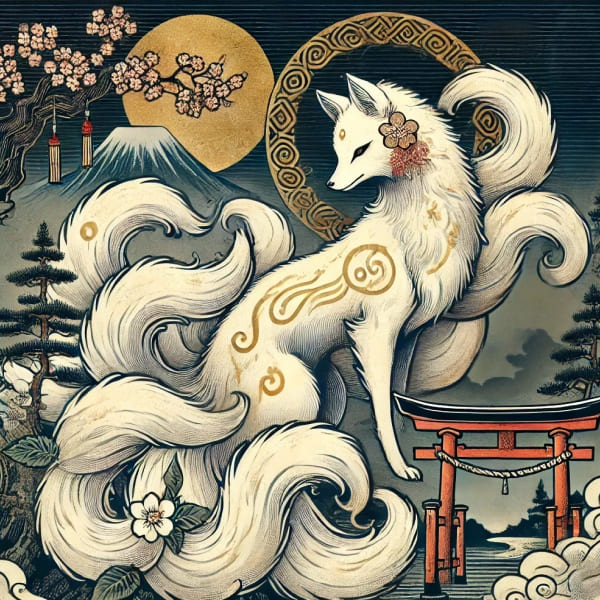
Contents
What if the most beautiful woman in Japan’s imperial court was not human at all— but a fox with nine tails?
Have you ever heard of a fox with nine tails? In Japan, this mysterious creature is said to be beautiful, clever—and dangerously powerful.
Sometimes it appears as a dazzling woman at the emperor’s court. Other times, it lingers as a cursed stone in the mountains. And yet, it also shows up in today’s anime, games, and even Pokémon.
The nine-tailed fox is a legend that still captivates people today. Join us on a journey to discover why this mysterious spirit continues to enchant, terrify, and inspire across the centuries.
The Nine-Tailed Fox: A Spirit Beyond the Ordinary
Before diving into the legends, let’s ask—what kind of creature is the nine-tailed fox?
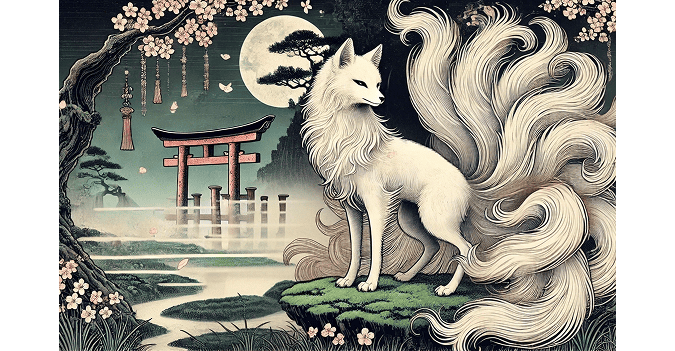
The nine-tailed fox (kyūbi no kitsune) is one of the most mysterious beings in Japanese folklore. It is said to be a fox that has lived for centuries, gaining such immense wisdom and power that it grows multiple tails—until it finally reaches its ultimate form with nine.
Beautiful yet dangerous, this spirit can take the shape of a dazzling woman, deceive nobles and emperors, and even bring calamity to an entire nation. Feared and admired through the centuries, the nine-tailed fox has been passed down in legends and continues to live on in Japan’s imagination today.
Foxes in Japanese Culture
To understand why the nine-tailed fox feels so special, we first need to know how foxes (kitsune) are viewed in Japan.
Since ancient times, foxes have been tied to nature’s cycles and farming life. Their seasonal appearances led people to see them as messengers of the gods who blessed the fields.
Over time, foxes took on two faces:
- Revered as the divine messengers of Inari, the deity of rice and prosperity
- Feared or amused as tricksters, shapeshifting to play pranks on humans

Because of this, foxes became more than animals—they were sacred protectors and mischievous deceivers, always close to daily life and belief.
How Is the Nine-Tailed Fox Different?
So, how exactly does it differ from the foxes people saw in daily life? Let’s take a closer look side by side.

| Aspect | Ordinary Fox (Kitsune) | Nine-Tailed Fox (Kyūbi no Kitsune) |
|---|---|---|
| Connection to People | Familiar in villages and rice fields | Appears in legends tied to emperors and nations |
| Role in Belief | Messenger of Inari; playful trickster in folktales | Ultimate spirit with near-divine powers |
| Abilities | Shapeshifting; playing pranks or small tricks | Shapeshifting; supernatural wisdom; deadly curses |
| Symbolism | Linked to harvest, prosperity, and daily life | Symbol of beauty, danger, and overwhelming power |
| Influence | Affects local communities and households | Shapes myths, history, and even imperial destiny |
This contrast shows why the nine-tailed fox is remembered not just as a fox, but as a living legend—beautiful, feared, and unforgettable.
A Famous Tale of the Nine-Tailed Fox
Now that we know what makes the nine-tailed fox so extraordinary, let’s turn to one of its most famous legends in Japan— the chilling story of Tamamo-no-Mae.
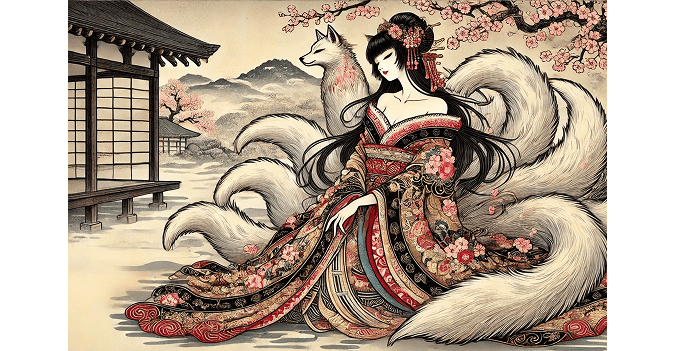
The Legend of Tamamo-no-Mae
Long ago, in the age of the Heian court, there lived a woman whose beauty was said to outshine the moon itself. Her name was Tamamo-no-Mae. She was graceful, wise, and spoke with such elegance that every noble who met her was instantly charmed. Even the emperor himself could not resist her presence, and soon she became his most beloved companion.
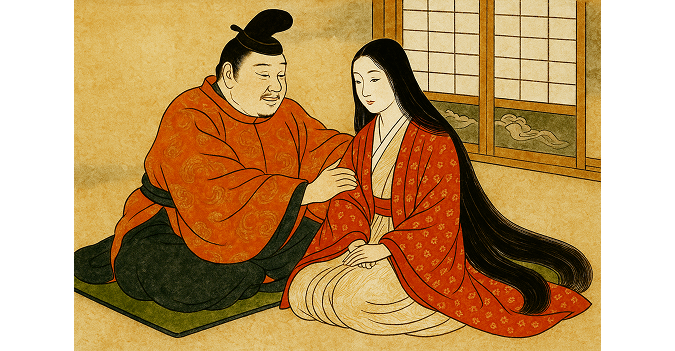
But perfection often carries a hidden shadow. Not long after Tamamo-no-Mae entered the palace, the emperor fell gravely ill. His condition worsened day by day, and no doctor or priest could find the cause.

Whispers began to spread through the court—was this dazzling woman somehow connected to his suffering?
At last, a powerful diviner was summoned. Then, the truth was revealed before the court:
Tamamo-no-Mae… she is no human, but the nine-tailed fox!
Her dazzling form had been nothing but a disguise— the nine-tailed fox itself, feeding upon the emperor’s very life force. When her secret was exposed, Tamamo-no-Mae vanished from the palace in an instant.
She fled across the land until she reached the wide plains of Nasu, in what is now Tochigi Prefecture. There, the emperor’s soldiers pursued her. A fierce battle followed, and with arrows and blades they struck her down.
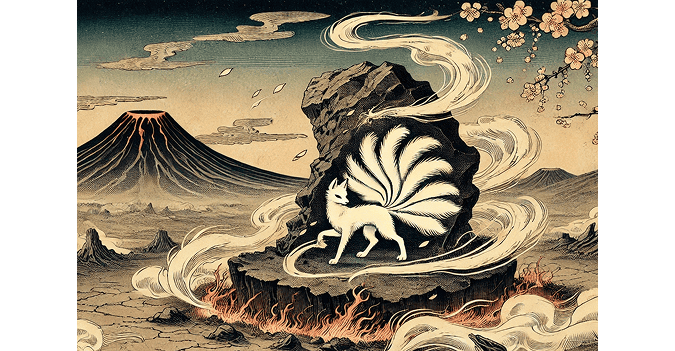
But death was not the end of her tale. Her spirit sank into a massive volcanic stone on the plain. From that day on, the stone was feared as the Sessho-seki—the Killing Stone. It was said that any person or creature who came too close would fall lifeless at its side, struck down by the lingering curse of the nine-tailed fox.
And so, the story of Tamamo-no-Mae is still told today, as if the echo of her curse has never truly faded.
The Curse of the Killing Stone
The story of Tamamo-no-Mae does not end with her fall. There is another chapter—about the stone said to hold her restless spirit, the Sessho-seki, the Killing Stone. Let us see how the tale continues.
The Stone of Death
For centuries after Tamamo-no-Mae was struck down, the Killing Stone was feared above all else. Villagers whispered that even birds that landed upon it would drop lifeless to the ground. Travelers avoided the area, and monks who dared approach were struck down by its poisonous aura.
People believed the curse of the nine-tailed fox still lingered within the stone, taking the life of any who came too close.
The Monk Who Broke the Curse
In the 14th century, a wandering monk named Genno passed through Nasu. When he heard of the stone’s deadly power, he declared:
Then I shall break this curse and free the people from their fear!
With solemn prayers and sacred chants, he lifted his hammer high and brought it crashing down. The Killing Stone split apart with a thunderous crack, shattering into three great fragments.
One piece remained in Nasu, where the stone can still be seen today. Another was said to have flown to Aizu in Fukushima, and the third to Bizen in Okayama.
And so, the legend of the nine-tailed fox spread far and wide— a tale of mystery and a cursed stone, told and retold through the generations. This is how the story we know today has survived, passed down from age to age.
Regional Legends Across Japan
We’ve just explored the most famous tale of the nine-tailed fox—but did you know that many regions of Japan tell the story in their own unique way?
In each place, the legend took on its own colors, woven into local beliefs, everyday life, and even the illnesses people feared. Here, let’s take a look at some of these fascinating regional variations.

-
Yamanashi Prefecture – The Pain of Ishibu
It is said that when a shard of the Killing Stone landed here, those who touched it would suffer pain in their feet, a mysterious condition known as Ishibu.
The curse was believed to strike anyone who stepped on the stone fragment. -
Kanagawa Prefecture – The Birth of the Kuda-gitsune
In this version, the nine-tailed fox named Kinko fled from China to Japan and became the Killing Stone.
When a monk split the stone, countless invisible fox spirits called kuda-gitsune were released. These spirits were said to possess people, causing them to eat enormous amounts of food without ever gaining weight. -
Wakayama Prefecture – The Curse of Komame
Here, the nine-tailed fox was described as a 9,000-year-old white fox who disguised itself as a court lady named Tamago-no-Mae.
After being defeated and turned into the Killing Stone, anyone who touched its fragments developed painful swellings on their skin called Komame. -
Shiga Prefecture – The Stone of Protection
In this tale, the fox queen was exposed when someone looked at her through a ring made of dove feathers.
After she fled and became a stone, a monk shattered it with his prayers.
One fragment was kept and revered—offered red rice on the 17th of each month, never to be used carelessly, as it was believed to protect the household from misfortune.
These variations show how one legend could transform into many forms across the country.
For villagers, the nine-tailed fox was not just a distant myth—it became part of their own world, tied to everyday fears, illnesses, and protective rituals. By linking unexplained misfortunes such as sickness, pain, or strange events to the fox’s curse, people found a way to give meaning—and sometimes protection—to the uncertainties of life.
From Stage to Anime: The Nine-Tailed Fox in Japanese Arts
The nine-tailed fox may have met its end in legend, but in Japanese culture it continues to reveal its mysterious, enchanting side—captivating people even today.
Let’s take a closer look at how the fox spirit lives on in Japan’s arts and imagination.
Traditional Performing Arts
In traditional theater, the legend of Tamamo-no-Mae is still performed today as part of the repertoire.
-
Noh Theater – Tamamo-no-Mae and Sessho-seki
Classical Noh plays retell the haunting story of the fox spirit revealed at court and her lingering curse in the Killing Stone.
With masks, slow movements, and chanting, these plays emphasize the eerie tension between beauty and terror.
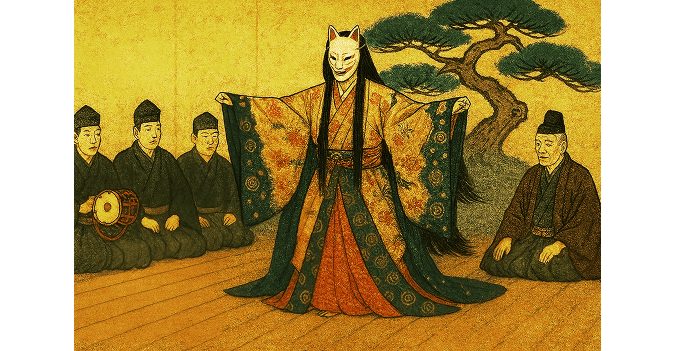
-
Kabuki and Joruri (Puppet Theater)
In Edo-period kabuki and bunraku, the tale of Tamamo-no-Mae was adapted into dramatic spectacles.
Plays such as Tamamo-no-Mae Asahi no Tamoto highlight her seduction, downfall, and the fierce battle at Nasu, mixing action with moral lessons. -
Picture Scrolls and Otogizōshi (Medieval Storybooks)
The nine-tailed fox also appeared in illustrated scrolls and storybooks as a cautionary figure—warning of the dangers hidden beneath beauty and temptation.
Modern Culture
In today’s popular culture, the nine-tailed fox is everywhere—from anime and games to novels and stage adaptations.
-
Anime and Manga
The nine-tailed fox remains alive in popular series such as NARUTO (Kurama, the nine-tailed beast), Fate/Grand Order (Tamamo-no-Mae), and Inuyasha.
Each reimagines the fox spirit as both powerful and mysterious, keeping its dual nature of allure and danger. -
Video Games
The fox spirit appears in games like Ōkami, Onmyoji, and the beloved Pokémon series.
-
Literature and Contemporary Retellings
From historical fantasy novels to modern horror, authors continue to reinvent Tamamo-no-Mae.
In Japan, she appears in works such as Yumemakura Baku’s Onmyoji series and modern plays like Tamamo-no-Mae, which continue to bring the legend to life for new audiences. Writers set her tale in new worlds—sometimes placing her back in the Heian court, other times imagining her wandering the streets of modern Tokyo.
Across all these forms, the nine-tailed fox remains more than just a character.
It is a symbol of mystery, transformation, and timeless fascination, bridging the world of ancient myth with today’s imagination.
Visiting the Sessho-seki Today
The Sessho-seki is not only a legend—it truly exists in Nasu, Tochigi Prefecture. Located about two hours from Tokyo, this hot spring region welcomes visitors who wish to see the famous “Killing Stone” for themselves.
Here, in the middle of steaming volcanic fields, lies the stone once feared for its deadly curse. Surrounded by sulfur vents and small shrines, the site feels otherworldly, as if the ancient tale still lingers in the air.
A Modern Mystery: The Stone Breaks in 2022
For centuries, the Sessho-seki stood in Nasu, but in 2022, it shocked Japan when it was discovered split in two—a dramatic event that quickly made national headlines.

Geologists explained the crack as the result of natural weathering and freezing, but on social media many wondered: Had Tamamo-no-Mae’s spirit finally escaped? Memes, jokes, and eerie speculation spread quickly online—showing how even today, this ancient legend continues to capture people’s imagination.
How to Visit
Thinking of seeing the legendary Sessho-seki in person?
Here’s a quick guide to help you get there.
- Access from Tokyo: Take the JR Tohoku Shinkansen to Nasushiobara Station (about 75 minutes). From there, a Kanto Bus to Nasu Onsen takes around 50 minutes.
- Admission: Free of charge.
- Best Time to Visit: Misty or cool days, when the steam rising around the rocks makes the site feel especially mystical.
Nearby Attractions
There’s plenty more to enjoy around the area—why not explore a few sights while visiting the Sessho-seki?
- Nasu Onsen – A famous hot spring resort area with traditional inns and open-air baths.
- Nasu Yuzen Shrine – A small shrine near the Killing Stone, dedicated to the fox spirit.
- Volcanic Walking Trails – Scenic paths across the geothermal landscape, perfect for short hikes.
- Foot Baths (Ashiyu) – Relax your feet in hot spring water while enjoying views of the steaming fields.
Travel Tip
Travel Tip: Wear comfortable shoes—the paths around the stone are rocky and can be slippery in wet weather.
And if you visit on a misty morning, you may just feel the lingering presence of the nine-tailed fox…
Conclusion: A Legend That Lives On

From the glittering courts of the Heian period to the steaming fields of Nasu, the nine-tailed fox has remained one of Japan’s most captivating legends. It has taken many forms—an enchanting woman, a cursed stone, a trickster spirit, and even a character in anime and games.
What makes this creature so unforgettable is its dual nature:
both beautiful and terrifying, protective yet destructive, human-like yet otherworldly. It reflects not only the fears of the past but also the timeless fascination with mystery and transformation.
Even today, the nine-tailed fox continues to remind us that legends never truly die— they simply take new shapes, waiting to enchant the next generation.